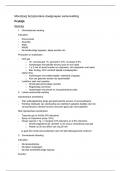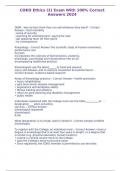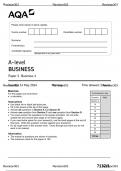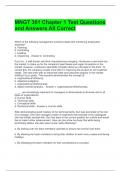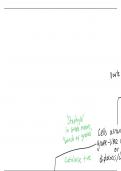Lecture 1: The Nature of Digital Technologies
MDI: What does the nature of digital technologies imply for the
management of digital innovations? 2 levels: industrial & firm level.
Reflect on 3 basic models of innovation
Industry level: technology life cycle models
Within development of industries à 2 main phases
Era of ferment: different designs competing for the same basic
design (a lot of companies/start-ups) E.g. Automobile industry:
combustion engine dominant design. After that, after a
dominant design emerges, only some organizations will
survive. Then there is a period of incremental changes until
there is a new technological discontinuity. E.g. mobile phone.
Digital inno: speed increased; boundaries industries become
unclear (e.g. smart homes)
Firm level (strategy): technology road mapping
Future vision for developments
Firm level (organization: routinization of innovation
Stage gate model: gates go/no go decisions
Funnel: start with many ideas and reduce them
PDMA: 80% of larger firms use this STM
Digital inno: revisiting stages, not done after launch
Digital innovation: use of digital technology in products,
services, business models and business processes.
Different definitions of digital inno across papers:
Incorporation of digital capabilities into objects that previously had a purely physical materiality (Yoo et al.
2012): combination of physical and digital
A product, service, process, or business model that is perceived as new, requires some significant changes on
the part of adopters, and is embodied in or enabled by IT (Fichman 2014): very broad
The creation of (and consequent change in) market offerings, business processes, or models that result from
the use of digital technology (Nambisan et al. 2017): same as we use in the course
Digitization: encoding of analog info into digital information: binary digits (bits)
,Digitalization: sociotechnical process of applying digitizing techniques to broader social and institutional
contexts
5 characteristics of digital
technologies
- homogenization & decoupling
- connectivity
- reprogrammable & smart
- digital traces
- modularity
Homogenization & decoupling
All digital information assumes the same form à it can be processed by the same tech à digitizing has
potential to remove tight couplings between info types and their storage, transmission, processing
technologies
Consequences of homogenization & decoupling:
Low marginal cost (additional cost of another unit are low)
- Digitized info can be transmitted, stored & computed in fast and low-
cost ways (electronics, electromagnetic waves, optic signals)
- Moore’s law: computing power (cost, speed) improves exponentially
e.g. the marginal cost of an algorithm is very low à easy scaling
Implications: disruption, winner-takes-all
Convergent user experience
Implications: convergence of industries; combinatorial innovation
Connectivity
- With other users
- With other applications (e.g. If this then that IFTTT à Philips hue)
- Between firm and customer
Consequences of connectivity:
(Between users) Network externalities: when the value of a good to a user increases with the number of
other users (installed base) of the same similar good (e.g. whatsapp, playstation 4)
Implications for innovation: disruption, winner-takes-all, ecosystems
(Between applications) Interoperability: the ability of a product or system to work with other
products or systems (there might be strategies making product not interoperable).
- Standardized and open interfaces (API’s)
- Interoperability drives network externalities
Implications for innovation management: platform ecosystems, combinatorial innovation
, Reprogramable & Smart
- Digital product scan be edited and reprogrammed (software updates)
- By suppler (connectivity!) or autonomously (machine learning!)
- Using sensors, processors, actuators
Consequence of reprogrammability:
Emerging functionalities:
- Product versioning
- Differentiation
- Incompleteness (never finished, malleable)
- Backward & forward compatibility
Implications for innovation: continuously development, agility, cross-functional integration
Consequence of connectivity & reprogrammability:
Servitization:
- Shift towards “service” (value, experience) that products offer (“job to be done”)
- Shift toward pay for use instead of pay for ownership (“pay per lux”, “power by the hour”, “X as a
Service”)
- Hybrids: interdependence à products require service and services require some form of product or
artifact (Barrett et al. 2015)
- Hybrids: integrating products and services into complex systems
Consequences of digital traces: wakes of innovation, Frans veldberg lecture à data generated can be used
for other innovations
Modularity
• A module is a unit whose elements are powerfully
connected among themselves and relatively weakly
connected to elements in other units (Baldwin &
Clark, 2000: 63)
• Modularity can be created by standardizing
interfaces between units
• Continuum from modular to integral designs
Layered modular architecture of digital technology
(Yoo et al, 2010) à
Affordances of pervasive digital technology (Yoo et al, 2012) à overarching characteristics that combine
several of the 5 characteristics discussed
Convergence (homogenizations & decoupling)
- Bringing together previously separate user experiences
- Integration of digital and material
- Convergence in industries
Generativity: inherently dynamic and malleable (can be changed over time)
- Reprogrammability
- Wakes of innovation (inno create possibilities of new inno’s to build upon that)
- Digital traces as by-products
Lecture 2: Digital Platforms
Gawer (2014) Platforms are evolving organizations or meta-organizations that:
• federate and coordinate constitutive agents who can innovate and compete

